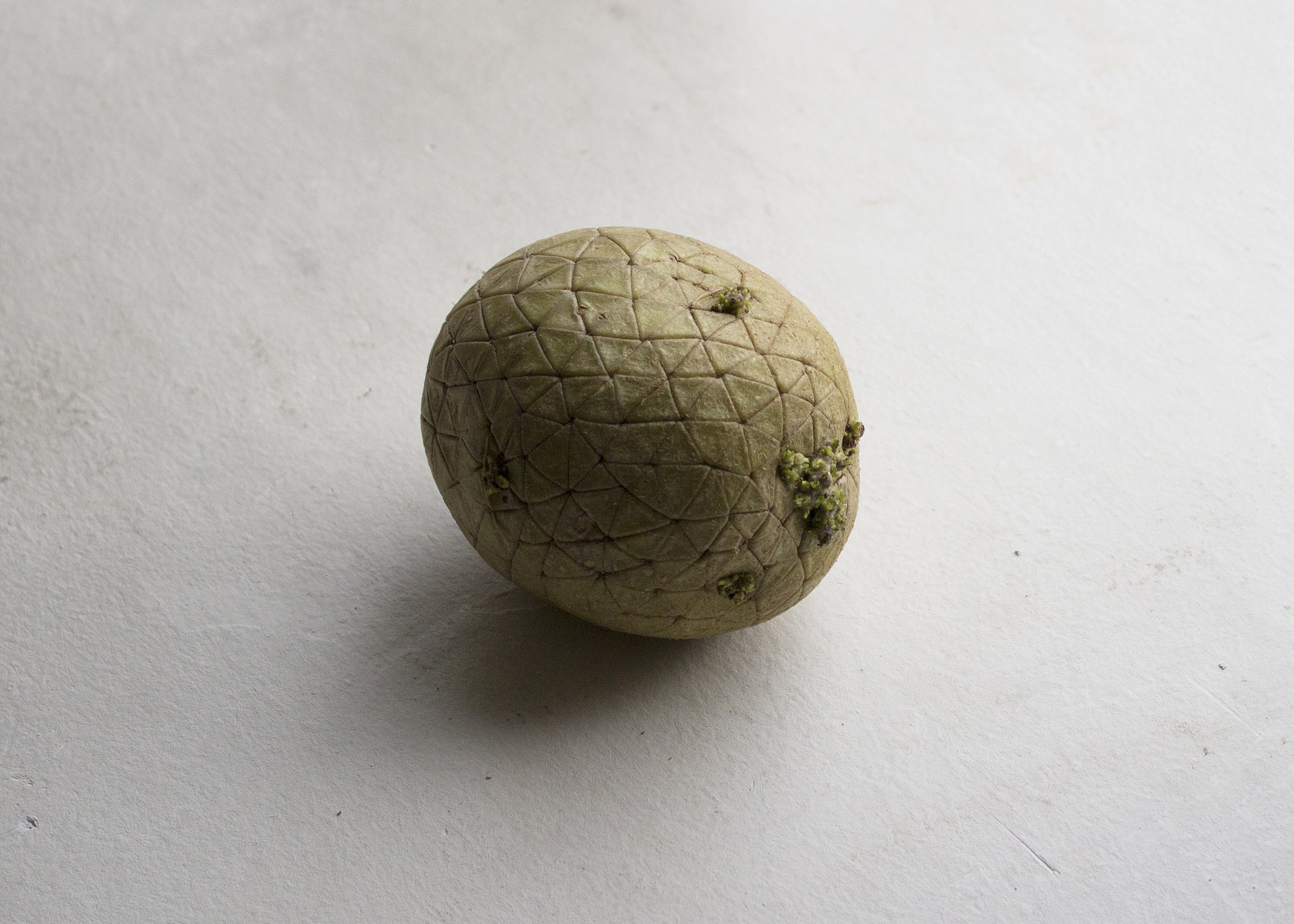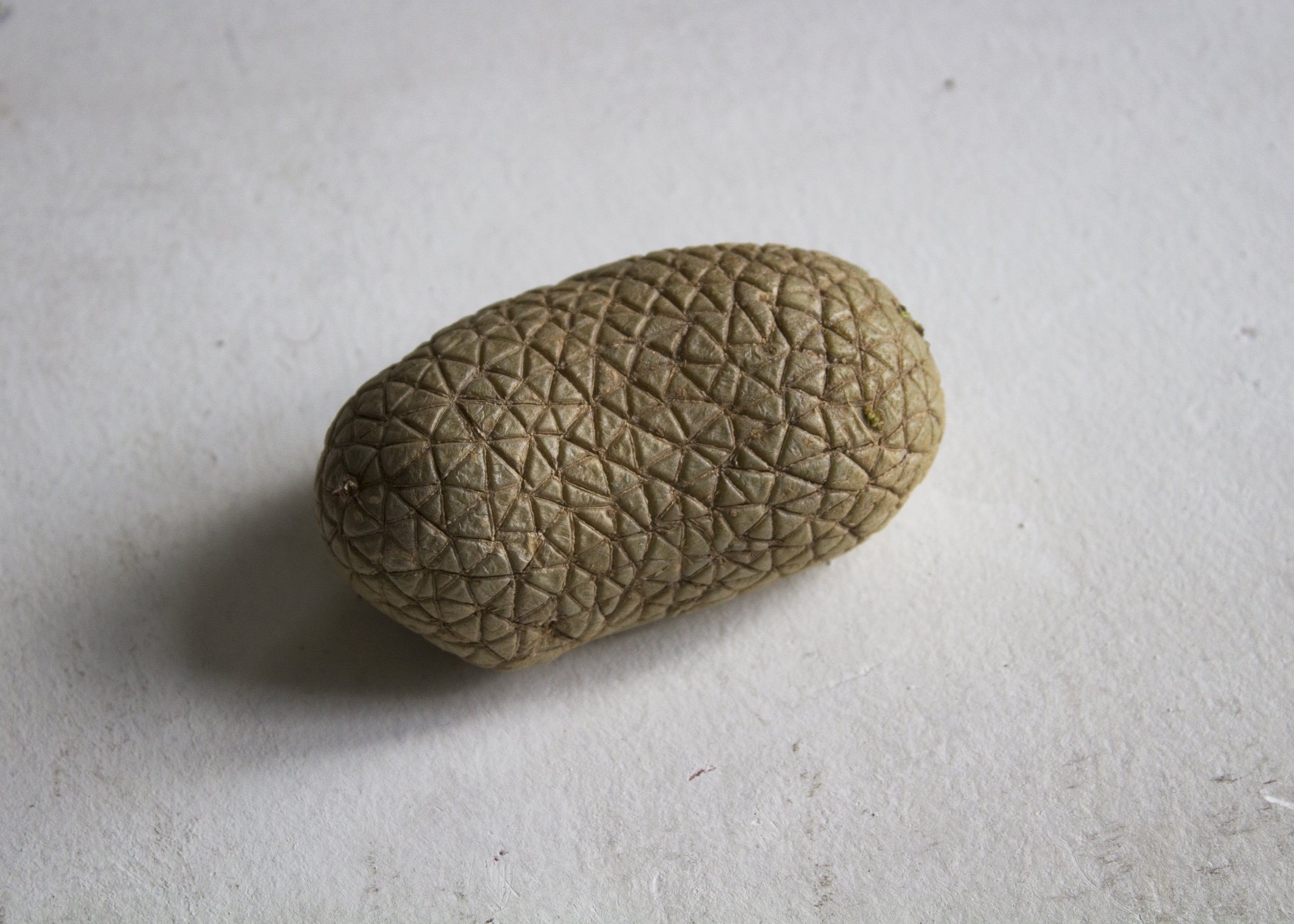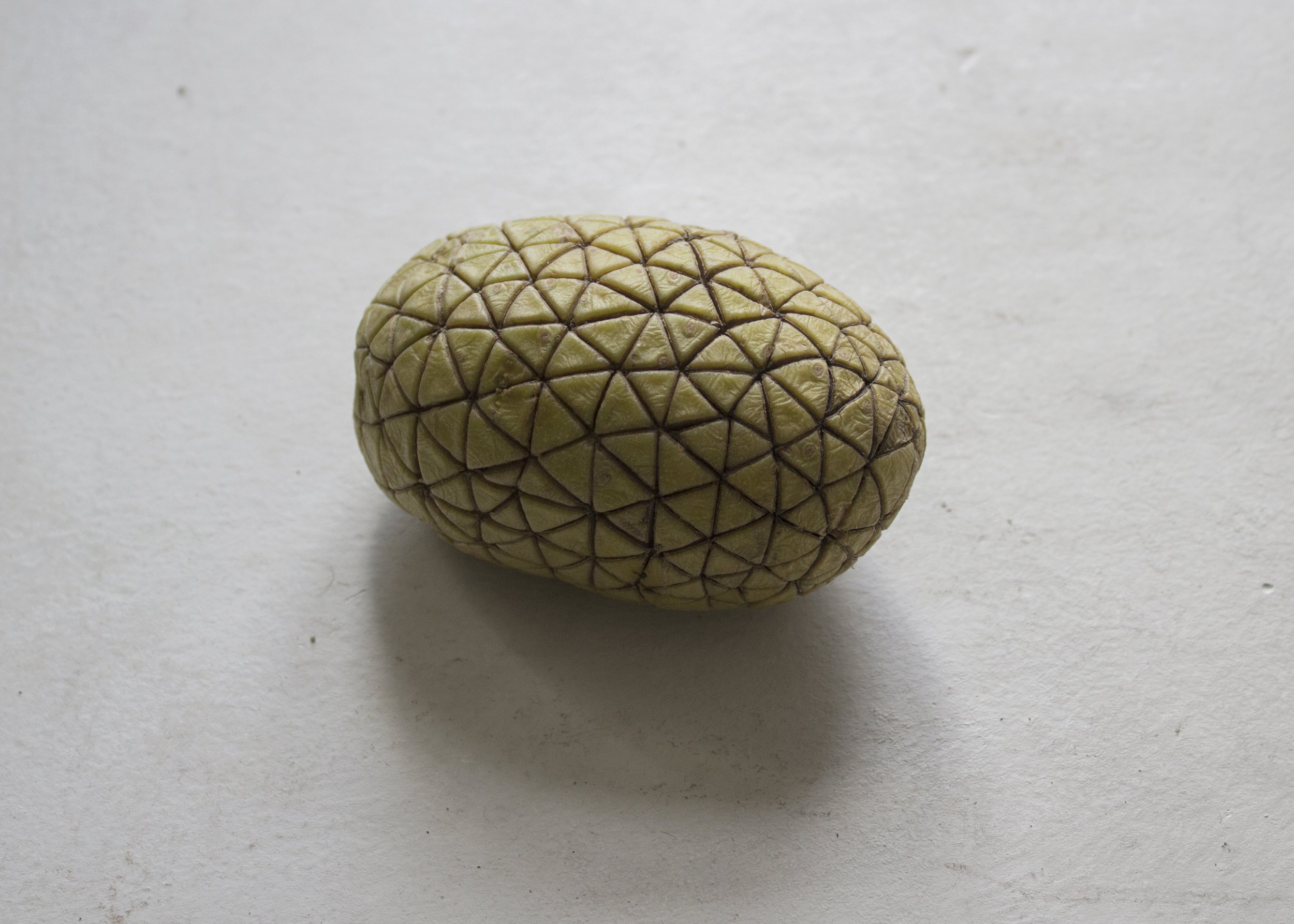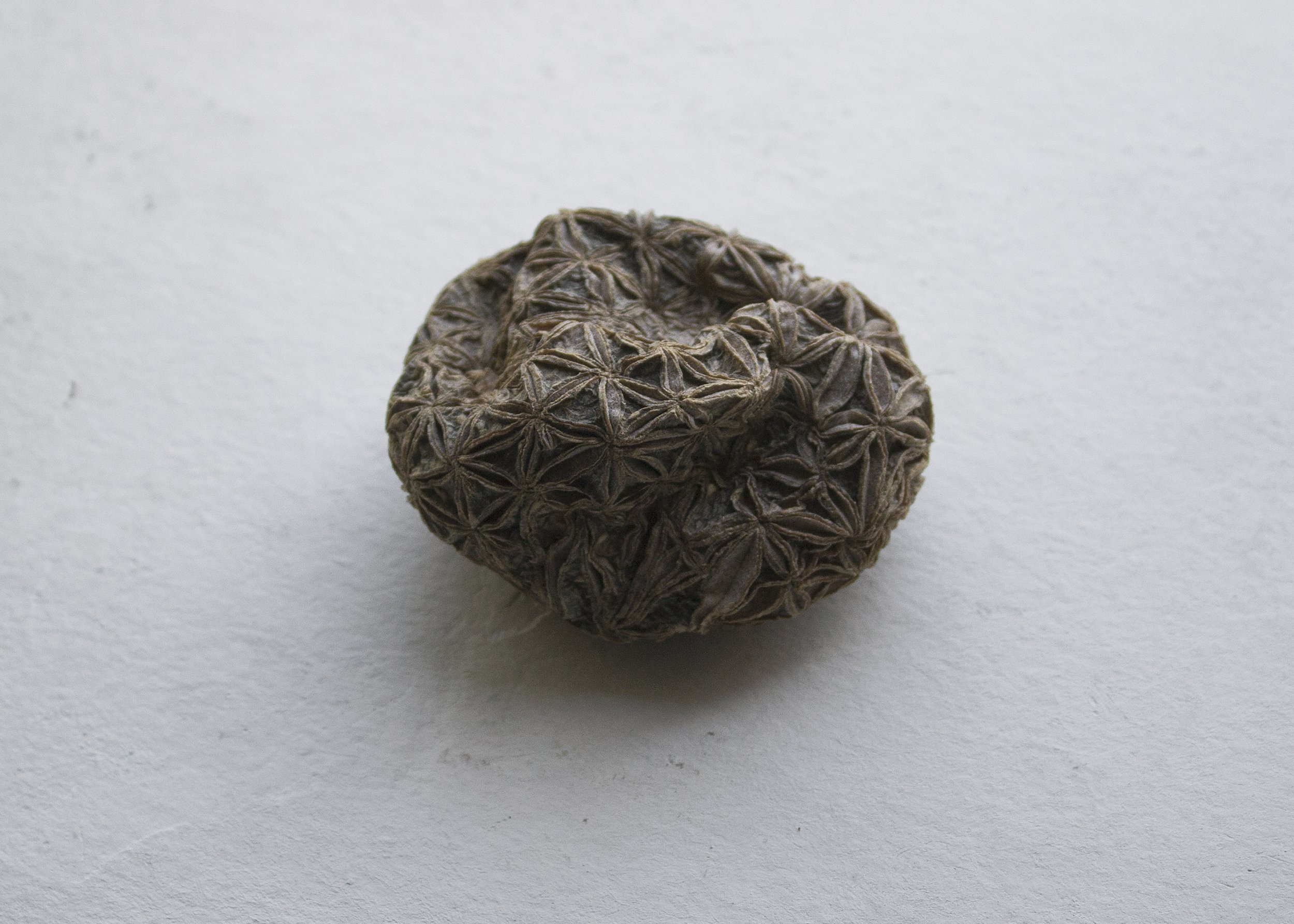“On Time, Art, and Entropy” Marcelo Guimarães Lima on Dimitris Theocharis
ON TIME, ART, AND ENTROPY: “The analysis of reality produces reality” by Dimitris Theocharis
ON GEOMETRY AND NATURAL OBJECTS AND PROCESSES
In the artwork titled “The analysis of reality produces reality” by Dimitris Theocharis, the surface of a potato is inscribed, incised with adjacent, ordered triangles in a kind of topological “mapping” of a natural object. The geometric elements, lines and figures, superimposed on the surface of the vegetable, help to highlight its elemental volume and presence, that is, they generalize by geometric surface representation its empirical, its “accidental”, unique natural shape into a kind of sublimated ideal form, universally apprehended and generically typified.
The potato itself, the vegetable, is also another type of “universal”, a quotidian “object” or entity, a general source of daily nourishment, first domesticated by native peoples in Peru and Bolivia around 10,000 years ago, today globally cultivated and consumed.
Lines, triangles, geometric forms in general are symbolic entities that serve cognitive and communication processes. They are common elements in the sciences and in art, as science and art are both specialized endeavors within a larger and total process of human adaptation to the world, of material and symbolic efforts for survival that implies the construction of a humanized symbolic and material environment, a specific reality within the larger reality, or realities, of the world.
In his works, Dimitri Theocharis utilizes his previous mathematical education and practice to perform a type of Debordian “détournement” (appropriation and deviation) of concepts and procedures from mathematical disciplines such as topology and geometry, and from other scientific fields, towards artistic praxis understood as a type of immanent interrogation of our lifeworld. An interrogation that utilizes also “transcendental” strategies and procedures, heterogeneous materials and ideas that clash and come together in the larger unity of structured artistic concepts and processes.
“The analysis of reality produces reality” is conceived as an evolving, time bound artwork. The raw vegetable that serves as its frame and support, dries, rots, and decays under inner and environmental conditions. Its surface changes form and sizes, and with it, the geometric designs are modified. The initial “collaborative” process between the artist and vegetable matter, involving graphic marks made by hand on a passive material support, evolves as natural chemical and physical processes take the main role in the continuous formative operation and its results.
Once the inscriptions are completed, biological time, the interconnected processes of growth and decay of living things, comes to the surface as the component that takes command and disturbs the work´s initial condition, its surface patterns, geometric logic, and topological formalization.
ON ART AND SCIENCE
Science and art, as we stated, are human products in the service of human needs and ends. Beginning with the human need to clarify what humans really need and should strive for. But they do so under specific conditions. Essentially, they re-produce reality, that is, they produce reality anew, both as a type of new reality, a kind of superlative reality, and, at the same time, they re-frame the very same reality that constitutes our world, as the unique and sole world-reality that we inhabit collectively: humans, animals, plants, rocks, planets, galaxies, etc. in an extended “brotherhood”, or “neighborhood” of the real.
As there is no life after this very life, except within the limited symbolic sense of our living memories, there is no world after this world, no other reality for us to act upon and to know. One is enough, and it is already a great challenge. Art and science are ways of creating meaning out of our experiences, ordinary and extraordinary, that is, they are ways of making the real intelligible, and of comprehending ourselves in it.
And they do so by roundabout ways, that is, they separate themselves from ordinary endeavors, from raw experiences, from the flux of lived time and recreate actions and thought processes as autonomous operations within an autonomous domain of sensibility and reason. Actions and processes that once completed, return to their sources in quotidian realities to illuminate our daily struggles and to clarify as much as possible means and ends in everyday life. (1)
The “odd” pictures of the universe and its material processes that the growth of scientific knowledge provides, including of our own human realities, show us that the real, in being what in fact it is and always, it is also multifaceted and multidimensional. In a similar way, art show us our own multidimensional inner reality. Objectivity in science it is both goal and medium: science proceeds by a process of de-anthropomorphization of the real, that is, by de-centering the “all too human” subject, with its fears and hopes, lacks and desires, as the private subject of representation and actions. The subject of knowledge in science is the collectivity of researchers, a trans-individual subject whose propelling desire it is the desire for the real, the passion of objectivity itself.
A similar process of subjective transformation, we can point out, is at work in art: the process named “estrangement”, brilliantly theorized in the literary arts by the Russian Formalists (2) in the beginning of the 20th century, by means of which our own passions, “our sufferings and doings” - to use the expression by philosopher John Dewey in his aesthetic investigations (3) - represented in art are de-familiarized, made “other”, made strange to ourselves.
The resulting emotional impact of finding new dimensions within what is most intimate and “self-evident” prompts, as a response, a de-centering and repositioning of the inner self, allowing active reflection within experience, the opening of new perspectives within a given subjective experience, transforming emotional experience from passive condition into inner activity and purpose.
A TOPOLOGY OF TIME AND PROCESS
Topological time is a concept developed by French philosopher Michel Serres that contrasts an understanding of historical time as linear succession with the idea of a multidimensional view of the nature of time and of human experience across and within time. The graphical example he gives us is: two given distant points in the surface of an open handkerchief. As the handkerchief is folded or crumpled, the actual relation of the points is now of proximity. Time understood as this multi layered dimension, this folded unity and multiplicity, allows us to think of new relations between past, present and possible futures. (4)
Examining the physics of the Roman philosopher and poet Lucretius, Michel Serres (5) points out its relations to a science of fluxes embodied in Roman engineering and waterworks, to Epicurean atomic concepts in which the ordered, straight fall of the atoms is disturbed by a sudden deviation, the clinamen, the consequent shock of elementary particles generating all that there is. The science of Epicurus and Lucretius is a science of the probable, rather than a deterministic account of the world.
Viewed from this perspective, De Rerum Natura by Lucretius (6), dating from the first century BCE, it is a work that anticipates or prefigures in some central or basic aspects the understanding of energy fluxes which started with modern Thermodynamics in the 19th century, the study of the phenomena related to the flux and dissipation of energy, and that forms today the basis of our contemporary concepts of matter and energy related to the processes of Entropy. Also, it is a work in which the language of science and the language of art (poetry) come together as one.
In “The analysis of reality produces reality”, as the potato dries and decays, changing its size and form, its pristine geometric patterned surface is transformed with creases and folds. We can say that against an initial linear, metric ordering, new topological relations are displayed in its surface. The new aspect and dark tones of the shrinking, crumpled vegetable may also suggest that other volume of natural living matter we carry within ourselves: brain matter with its gray tonalities and whose folded disposition is indeed a structural, layered principle of organization, communication, and performance.
Analogies and dissonances, formal and material kinships, and conflicts, both internal and external, are what works of art are made of. Between what is substantially or formally presented, displayed, described, or represented in a work of art, and how that presentation, representation, description, etc., is given or produced, the unity of the artwork is a dialectical one, that is, made of generative contradictions and conflicts.
In the case of Dimitri Theocharis´ work, what we may call its geometric, mathematical formal “superstructure”, ideal, that is, belonging to a domain beyond common time effects or determinations in its specific reality and significance, is built upon an “infrastructure” of organic matter destined to decay and to disintegrate.
A rotten potato, with its blemishes, juices, stains, at times its odors, is not per se a usual object of contemplation, aesthetic or otherwise. Within the framework of its ideal, formal, abstract surface elements, as time takes its course in the art gallery space, we contemplate a type of “natural entropic process” in artistic form.
AN ANIMATED REALITY
It goes without saying that, at this point, something of a discreet uneasiness may reverberate within ourselves. We can say that, at this time, again in a kind of dialectical reversal, one more within the experience of art, as the viewer contemplates a concentrated representation of the works of time, a portrayal of impermanence as such, the viewer´s anthropomorphic disposition, the source of our inner poetic capacities, that capacity for universal identification and affective exchanges with the world as such, takes hold, discreetly but surely.
In Ancient Greece, public and votive statues, decorative or functional objects, carried inscriptions declaring their identities: “I am the vessel such and such…”, “I am the statue of…”, “I am the knife of…”, “I was made by…”, “I was dedicated to the god and given to the temple by…”. As Jean Zafiropoulo observes (7), in these inscriptions the souls of the objects themselves directly spoke to the viewers or users. This reflected, even during Classical times, the survival of earlier animistic concepts that can be also detected in the beginnings of Philosophy, the idea of a soul of the world, of an animated reality and of universal communication with the world at large.
In a reflected and rationalized way, considered as play, as fiction, as a self-conscious duplication of reality, as a model of our inner world and of our life context, the work of art today, from its material shell and symbolic “soul”, also speaks in intimate ways to ourselves. And it repeats always that ancient saying: De te fabula narratur – This is your story.
In the present work, this narrative layer is somewhat understated, discreetly presented, and yet, it is also the unmistakable story – within the actuality – of real decomposition and disappearance in time. Among other aspects, it is the narrative of time itself as universal leveler.
TRANSITIONS
Irreversibility, the realities of the Arrow of Time in our common experience, has entered modern science, against the Newtonian paradigm of time symmetry, that is, of reversible time, with the investigation of the phenomena related to Entropy. Entropy is a fundamental and debated concept in contemporary physics, and it tells us that the universe is destined, when all energy is dissipated, to end in “dis-order”, in an undifferentiated state called “heath death” or “big freeze”, a passive state of thermal equilibrium where no energy is left to produce further diversified results.
A topology of inner experience can indicate the layers of heterogeneous categories, determinants or perspectives within our subjective disposition that come together in the arts. The artistic experience is built upon such a complex amalgam of time elements, of various structural strata, developmental cycles and stages in our perceptions and concepts.
Every form is the product of a process, and that includes not just the evident aspects of biological forms, but also geometric forms and the various mathematical entities which are always the results of formal operations. In Dimitris Theocharis´ work, the artist brings together different aspects of mathematical and biological processes. The result is an artwork that, on one hand, it is formally concise, economic in its means, to the point in its discursive intentions, a type of sober and therefore “elegant” work within its own measures.
On the other hand, it contrasts two parallel and “open ended” series: one ideal, made of conceptual perspectives, the other material, that speaks about our own finite material reality, and reminds us of the perennial difficulties of mediating between the two. The artistic synthesis, in this sense, it is always precarious, provisional, temporary as our own subjective life-synthesis, and knows itself as such.
References:
1. Lukács, György. Estética. Grijalbo,1966.
2. Shklovsky, Viktor, Theory of Prose. Translated by Benjamin Sher, Dalkey Archive Press, 1990
3. Dewey, John, Art as Experience, Capricorn Books, 1958
4. Serres, Michel, Eclaircissements. Cinq entretiens avec Bruno Latour, Editions François Bourin, 1992
5. Serres, Michel, The Birth of Physics, Translated by Jack Hawkes, Clinamen Press, 2001
6. Lucretius, On the Nature of Things, Translated by Martin Ferguson Smith, Hackett Publishing Co., 2001
7. Zafiropoulo, Jean, L'Âme Des Choses, Les Belles Lettres,1967.
Dimitris Theocharis born in Greece (1987). He graduated from the School of Visual and Applied Arts, Aristotle University of Thessaloniki (2017) and received his master’s degree from the Sandberg Institute in Amsterdam (2020). He also holds a bachelor’s degree in Mathematics. His work encompasses a wide range of media, including video, photography, sculptures, and public interventions.




